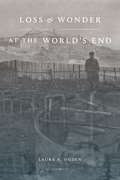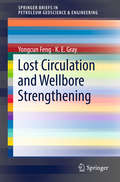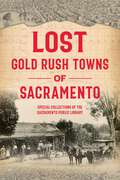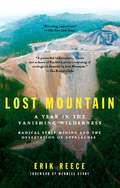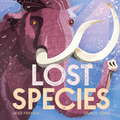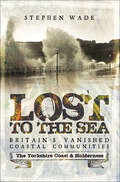- Table View
- List View
Losing Paradise
by Paul G. IrwinThe last decades of the twentieth century saw an unprecedented assault by humans on nature and animals throughout the world. Instead of moving toward a better world, we are now facing a tidal wave of ecological challenges that threatens to sweep away whatever progress we have achieved.In this landmark book, author Paul G. Irwin presents an alarming look at what we have done—and continue to do—to animals, to our environment, and to ourselves. Losing Paradise first examines the beliefs that lie at the core of our destructive actions—beliefs that place humans above and against nature. It then details the results of these distorted values, including the cruel treatment of animals through factory farming, hunting, and trapping, and the destruction of our environment. But while Losing Paradise shows the damage we have done, it also shows the steps we can take to build a truly humane society and reclaim our wondrous natural world. Most important, it reminds us of the paradise this earth can be for all God&’s creatures.
Losing Paradise: The Water Crisis in the Mediterranean (Voices In Development Management Ser.)
by Gail Holst-Warhaft Tammo SteenhuisTaking a uniquely interdisciplinary view of the Eastern Mediterranean region's water problems, this book considers some of the technical and regulatory solutions being proposed or implemented to solve the difficulties of diminished or polluted water supplies. Stressing the importance of traditional and historical cultural understanding in addressing the water crisis, the authors demonstrate that what is required is an integrated legal, social and scientific management system appropriate to each country's stage of development and their cultural heritage. Using case studies from Lebanon, Italy, Spain, Egypt, Greece, Jordan and Cyprus, the authors focus on the urgency of the present crisis faced by each country and the need for cooperation. The suggested solutions also serve as a paradigm for the rest of the world as it faces similar issues of water shortage.
Loss and Damage from Climate Change: Concepts, Methods and Policy Options (Climate Risk Management, Policy and Governance)
by Reinhard Mechler Swenja Surminski Laurens M. Bouwer Thomas Schinko JoAnne Linnerooth-BayerThis book provides an authoritative insight on the Loss and Damage discourse by highlighting state-of-the-art research and policy linked to this discourse and articulating its multiple concepts, principles and methods. Written by leading researchers and practitioners, it identifies practical and evidence-based policy options to inform the discourse and climate negotiations.With climate-related risks on the rise and impacts being felt around the globe has come the recognition that climate mitigation and adaptation may not be enough to manage the effects from anthropogenic climate change. This recognition led to the creation of the Warsaw International Mechanism on Loss and Damage in 2013, a climate policy mechanism dedicated to dealing with climate-related effects in highly vulnerable countries that face severe constraints and limits to adaptation. Endorsed in 2015 by the Paris Agreement and effectively considered a third pillar of international climate policy, debate and research on Loss and Damage continues to gain enormous traction. Yet, concepts, methods and tools as well as directions for policy and implementation have remained contested and vague.Suitable for researchers, policy-advisors, practitioners and the interested public, the book furthermore:• discusses the political, legal, economic and institutional dimensions of the issue• highlights normative questions central to the discourse• provides a focus on climate risks and climate risk management.• presents salient case studies from around the world.
Loss and Wonder at the World’s End
by Laura A. OgdenIn Loss and Wonder at the World's End, Laura A. Ogden brings together animals, people, and things—from beavers, stolen photographs, lichen, American explorers, and birdsong—to catalog the ways environmental change and colonial history are entangled in the Fuegian Archipelago of southernmost Chile and Argentina. Repeated algal blooms have closed fisheries in the archipelago. Glaciers are in retreat. Extractive industries such as commercial forestry, natural gas production, and salmon farming along with the introduction of nonnative species are rapidly transforming assemblages of life. Ogden archives forms of loss—including territory, language, sovereignty, and life itself—as well as forms of wonder, or moments when life continues to flourish even in the ruins of these devastations. Her account draws on long-term ethnographic research with settler and Indigenous communities; archival photographs; explorer journals; and experiments in natural history and performance studies. Loss and Wonder at the World's End frames environmental change as imperialism's shadow, a darkness cast over the earth in the wake of other losses.
Lost Circulation and Wellbore Strengthening (Springerbriefs In Petroleum Geoscience And Engineering Ser.)
by Yongcun Feng K. E. GrayThis book focuses on the underlying mechanisms of lost circulation and wellbore strengthening, presenting a comprehensive, yet concise, overview of the fundamental studies on lost circulation and wellbore strengthening in the oil and gas industry, as well as a detailed discussion on the limitations of the wellbore strengthening methods currently used in industry. It provides several advanced analytical and numerical models for lost circulation and wellbore strengthening simulations under realistic conditions, as well as their results to illustrate the capabilities of the models and to investigate the influences of key parameters. In addition, experimental results are provided for a better understanding of the subject. The book provides useful information for drilling and completion engineers wishing to solve the problem of lost circulation using wellbore strengthening techniques. It is also a valuable resource for industrial researchers and graduate students pursuing fundamental research on lost circulation and wellbore strengthening, and can be used as a supplementary reference for college courses, such as drilling and completion engineering and petroleum geomechanics.
Lost Crops of Africa: volume I
by National Research Council StaffScenes of starvation have drawn the world's attention to Africa's agricultural and environmental crisis. Some observers question whether this continent can ever hope to feed its growing population. Yet there is an overlooked food resource in sub-Saharan Africa that has vast potential: native food plants.When experts were asked to nominate African food plants for inclusion in a new book, a list of 30 species grew quickly to hundreds. All in all, Africa has more than 2,000 native grains and fruits--"lost" species due for rediscovery and exploitation.This volume focuses on native cereals, including African rice, reserved until recently as a luxury food for religious rituals. Finger millet, neglected internationally although it is a staple for millions. Fonio (acha), probably the oldest African cereal and sometimes called "hungry rice." Pearl millet, a widely used grain that still holds great untapped potential. Sorghum, with prospects for making the twenty-first century the "century of sorghum." Tef, in many ways ideal but only now enjoying budding commercial production. Other cultivated and wild grains. This readable and engaging book dispels myths, often based on Western bias, about the nutritional value, flavor, and yield of these African grains.Designed as a tool for economic development, the volume is organized with increasing levels of detail to meet the needs of both lay and professional readers. The authors present the available information on where and how each grain is grown, harvested, and processed, and they list its benefits and limitations as a food source.The authors describe "next steps" for increasing the use of each grain, outline research needs, and address issues in building commercial production.Sidebars cover such interesting points as the potential use of gene mapping and other "high-tech" agricultural techniques on these grains.This fact-filled volume will be of great interest to agricultural experts, entrepreneurs, researchers, and individuals concerned about restoring food production, environmental health, and economic opportunity in sub-Saharan Africa.Selection, Newbridge Garden Book Club
Lost Geographies of Power (RGS-IBG Book Series #79)
by John AllenThis original study explores the difference that space and spatiality make to the understanding of power. Explores the difference that space and spatiality makes to an understanding of power. Moves forward the incorporation of ideas of space into social theory. Presents a new understanding of the exercise, uses and manifestations of cultural, economic and political power in the second half of the twentieth century. Illustrated with cases and examples.
Lost Gold Rush Towns of Sacramento (Lost)
by Sacramento Public Library AuthorityThe Cannibal CityIn the early days of the California Gold Rush, Sacramento City had several competing towns vying for the influx of newcomers. Many of its rivals not only had vibrant multicultural communities but also enjoyed superior geography for transportation and flood control. Even the initial land grant from Johann Sutter is considered controversial if not downright fiction, yet Sacramento thrived where others failed. Once-bustling Mormon Island was initially the proposed site of the railway that would end up bypassing it, and Brighton became a hotbed of agitation after the deadly “Squatters’ Riot,” leading to its decline. Hoboken, Prairie City and more were also wiped off the map. The Special Collections of the Sacramento Public Library explores the history of these lost Sacramentos.
Lost Mountain: A Year in the Vanishing Wilderness Radical Strip Mining and the Devastation of Appalachia
by Erik ReeceThe mountains of Appalachia are home to one of the oldest and most diverse ecosystems in North America. But they are also host to the mother lode of American coal, and a new form of strip mining has created a state of emergency for the Appalachian wilderness and the communities that depend on it. In powerful, stirring prose Erik Reece chronicles the year he spent witnessing the systematic decimation of a single mountain in Kentucky, exposing how issues of corporate hubris, government neglect, and class conflict have all contributed to the crisis. This book is a landmark defense of a natural treasure, a core part of our national identity threatened with extinction. Winner of the Sierra Club's David R. Brower Award for Environmental Journalism.
Lost Species
by Jess FrenchStep into an incredible lost world and marvel at the strange and magnificent creatures that once roamed our Earth. From the awe-inspiring woolly mammoth and the ferocious Spinosaurus to the shy Chinese river dolphin and incredibly rare Pinta Island tortoise 'Lonesome George', meet 35 extinct species and discover how these creatures came under threat. Featuring additional information on 'Lazarus species' (animals declared extinct but which, amazingly, have been rediscovered in the wild), and mass extinction events, including the part we are playing in endangering our wildlife, the book shows young readers that extinction is not simply a part of ancient history - it is happening right now across the planet - but that if we all make some small changes to our lifestyles, our wonderful species can be saved. With beautiful and vibrant illustrations throughout, this stunning large format compendium is a reminder of the remarkable animals we have lost, as well as a celebration of those that have returned from the brink of extinction.
Lost Woods (The Discovered Writing of Rachel Carson)
by Rachel CarsonProvides a sense of "Silent Spring" (1962) author Rachel Carson's evolution as a writer and thinker through a presentation of some of her less-known writings including field notebook entries, letters, magazine articles, and a television script.
Lost in Math: How Beauty Leads Physics Astray
by Sabine HossenfelderA contrarian argues that modern physicists' obsession with beauty has given us wonderful math but bad science Whether pondering black holes or predicting discoveries at CERN, physicists believe the best theories are beautiful, natural, and elegant, and this standard separates popular theories from disposable ones. This is why, Sabine Hossenfelder argues, we have not seen a major breakthrough in the foundations of physics for more than four decades. The belief in beauty has become so dogmatic that it now conflicts with scientific objectivity: observation has been unable to confirm mindboggling theories, like supersymmetry or grand unification, invented by physicists based on aesthetic criteria. Worse, these "too good to not be true" theories are actually untestable and they have left the field in a cul-de-sac. To escape, physicists must rethink their methods. Only by embracing reality as it is can science discover the truth.
Lost to the Sea, Britain's Vanished Coastal Communities: Britain's Vanished Coastal Communities: The Yorkshire Coast And Holderness
by Stephen WadeOnce there was a Roman settlement on what is now Filey Brig. In Holderness, a prosperous town called Ravenser saw kings and princes on its soil, and its progress threatened the good people of Grimsby. But the Romans and the Ravenser folk are long gone, as are their streets and buildings sunk beneath the hungry waves of what was once the German Ocean.Lost to the Sea: The Yorkshire Coast & Holderness tells the story of the small towns and villages that were swallowed up by the North Sea. Old maps show an alarming number of such places that no longer exist. Over the centuries, since prehistoric times, people who settled along this stretch have faced the constant and unstoppable hunger of the waves, as the Yorkshire coastline has gradually been eaten away. County directories of a century ago lament the loss of communities once included in their listings; cliffs once seeming so strong have steadily crumbled into the water. In the midst of this, people have tried to live and prosper through work and play, always aware that their great enemy, the relentless sea, is facing them. As the East Coast has lost land, the mud flats around parts of Spurn, at the mouth of the Humber, have grown. Stephen Wades book tells the history of that vast land of Holderness as well, which the poet Philip Larkin called the end of land.
Lost to the Sea, Britain's Vanished Coastal Communities: Norfolk and Suffolk
by Stephen WadeLost to the Sea: Norfolk & Suffolk relates the stories of how the human communities along the coast of these counties maintained their struggle with the sea. From very early Neolithic times, when global changes created the Continental Shelf and raised the cliffs along Britain's eastern shorelines, through Roman and medieval times, the first villages and towns were gradually established, only to be faced with the problem of the sea's incursions onto agricultural land. In the 1950s, Rowland Parker's classic study of Dunwich, a key town of Suffolk engulfed, set the scene for a long-standing interest in how the sea's challenge has been met. There have been successes and failures, and Stephen Wade tells the story of the seaside holiday towns and fishing communities that have had to struggle for survival.In this book, the reader will find stories of the people involved in this titanic effort through the centuries. The narrative moves down the coast from Hunstanton to Southwold, tracing the losses and the gains, not only in measurements of land, but in the tough human experience of that environmental history.
Lost: Discover disappearing wonders
by Jess McGeachinA book that explores what it means to be lost, in all sorts of ways. The story of our world is one of constant change. At times it's been slow, as animals evolved and continents drifted apart. But it's also been rapid - like the giant asteroid that ended the reign of the dinosaurs. Lost asks readers what it means to be here and gone on our tiny planet. They'll find lost cities like Machu Picchu and Pompeii, meet amazing megafauna that once roamed the earth and learn about contemporary species under threat. They'll discover that sometimes being lost the safest place to be - just ask the cleverly camouflaged animals hiding in plain sight.
Louisiana Herb Journal: Healing on Home Ground
by Corinne MartinIn a world of constant change and crisis, the relationship between humans and their environment has never been more vital. Louisiana Herb Journal invites readers into the world of medicinal herbs, introducing fifty herbs found in Louisiana, with details on identification, habitat, distribution, healing properties, and traditional uses, including instruction on popular preparation methods such as tinctures and teas. Interspersed with these practical details, herbalist Corinne Martin shares stories that foster a true connection between readers and the world around them, from tales of childhood cherry picking to harvest mishaps to folklife traditions passed down through the generations. Accessible to experienced and rookie herbalists alike, Louisiana Herb Journal offers a new way of looking at the natural world, getting to know one’s “home ground” through a lens of healing and participation.Family connections, an intimate knowledge of the surrounding lands and waters, strong community bonds, an irrepressible resilience, and a great capacity for celebrating life despite hardships are part and parcel of what it means to be from Louisiana. A celebration of the state and the cultures of those who live there, Louisiana Herb Journal reflects on the value of medicinal herbs in promoting personal healing and addressing current challenges to the state’s environmental and economic stability. Readers will gain a deeper recognition of the natural wealth Louisiana enjoys and the ways that our stewardship of wild plants can impact our personal health as well as the state’s ecological future.
Louisiana's Response to Extreme Weather: A Coastal State's Adaptation Challenges and Successes (Extreme Weather and Society)
by Shirley LaskaThis book is open access under a CC BY 4.0 license.This book takes an in-depth look at Louisiana as a state which is ahead of the curve in terms of extreme weather events, both in frequency and magnitude, and in its responses to these challenges including recovery and enhancement of resiliency.Louisiana faced a major tropical catastrophe in the 21st century, and experiences the fastest rising sea level. Weather specialists, including those concentrating on sea level rise acknowledge that what the state of Louisiana experiences is likely to happen to many more, and not necessarily restricted to coastal states. This book asks and attempts to answer what Louisiana public officials, scientists/engineers, and those from outside of the state who have been called in to help, have done to achieve resilient recovery. How well have these efforts fared to achieve their goals? What might these efforts offer as lessons for those states that will be likely to experience enhanced extreme weather? Can the challenges of inequality be truly addressed in recovery and resilience? How can the study of the Louisiana response as a case be blended with findings from later disasters such as New York/New Jersey (Hurricane Sandy) and more recent ones to improve understanding as well as best adaptation applications – federal, state and local?
Love Castaway
by Cara CooperDr Nancy Taylor, is contented with her lone conservationist role on a desert island. When Gareth Marrs lands his plane she wants him out of there. She craves isolation from the real world where she made a mistake so awful she cannot bear to return.Owner of a luxury cruise line, Gareth plans to profit from her precious hideaway. He is less than honest with Nancy about his reasons for being there. When the island is attacked by Somalian pirates, Gareth not only protects Nancy but begins to understand why she has shut herself away. He is deeply attracted to the beautiful enigmatic scientist, so different from the shallow conquests in his city home. When he awakens the emotions she has hidden for so long, Gareth offers a chance of happiness. But Nancy discovers his real reason for invading her hidden paradise, incensed, she orders him out of her life forever. Gareth isn’t a man so easily brushed off. Besides he knows the only future he can contemplate lies with her if only he can get her to face up to her demons.
Love Castaway
by Cara CooperDr Nancy Taylor, is contented with her lone conservationist role on a desert island. When Gareth Marrs lands his plane she wants him out of there. She craves isolation from the real world where she made a mistake so awful she cannot bear to return.Owner of a luxury cruise line, Gareth plans to profit from her precious hideaway. He is less than honest with Nancy about his reasons for being there. When the island is attacked by Somalian pirates, Gareth not only protects Nancy but begins to understand why she has shut herself away. He is deeply attracted to the beautiful enigmatic scientist, so different from the shallow conquests in his city home. When he awakens the emotions she has hidden for so long, Gareth offers a chance of happiness. But Nancy discovers his real reason for invading her hidden paradise, incensed, she orders him out of her life forever. Gareth isn’t a man so easily brushed off. Besides he knows the only future he can contemplate lies with her if only he can get her to face up to her demons.
Love Letter to the Earth
by Thich Nhat HanhWhile many experts point to the enormous complexity in addressing issues ranging from the destruction of ecosystems to the loss of millions of species, Thich Nhat Hanh identifies one key issue as having the potential to create a tipping point.<P> He believes that we need to move beyond the concept of the "environment," as it leads people to experience themselves and Earth as two separate entities and to see the planet only in terms of what it can do for them. Thich Nhat Hanh points to the lack of meaning and connection in peoples' lives as being the cause of our addiction to consumerism. He deems it vital that we recognize and respond to the stress we are putting on the Earth if civilization is to survive. Rejecting the conventional economic approach, Nhat Hanh shows that mindfulness and a spiritual revolution are needed to protect nature and limit climate change. Love Letter to the Earth is a hopeful book that gives us a path to follow by showing that change is possible only with the recognition that people and the planet are ultimately one and the same.
Love Letter to the Planet
by Thich Nhat Hanh<A Love Letter to the Planet is part of the Parallax Press Moments series of short ebooks. It is a passionate appeal from Zen Master Thich Nhat Hanh for ecological mindfulness and strengthening our relationship to the Earth.
Love and Math: The Heart of Hidden Reality
by Edward FrenkelWhat if you had to take an art class in which you were only taught how to paint a fence? What if you were never shown the paintings of van Gogh and Picasso, weren’t even told they existed? Alas, this is how math is taught, and so for most of us it becomes the intellectual equivalent of watching paint dry. In Love and Math, renowned mathematician Edward Frenkel reveals a side of math we’ve never seen, suffused with all the beauty and elegance of a work of art. In this heartfelt and passionate book, Frenkel shows that mathematics, far from occupying a specialist niche, goes to the heart of all matter, uniting us across cultures, time, and space. Love and Math tells two intertwined stories: of the wonders of mathematics and of one young man’s journey learning and living it. Having braved a discriminatory educational system to become one of the twenty-first century’s leading mathematicians, Frenkel now works on one of the biggest ideas to come out of math in the last 50 years: the Langlands Program. Considered by many to be a Grand Unified Theory of mathematics, the Langlands Program enables researchers to translate findings from one field to another so that they can solve problems, such as Fermat’s last theorem, that had seemed intractable before. At its core, Love and Math is a story about accessing a new way of thinking, which can enrich our lives and empower us to better understand the world and our place in it. It is an invitation to discover the magic hidden universe of mathematics.
Love for the Land: Lessons from Farmers Who Persist in Place (Yale Agrarian Studies Series)
by Brooks LambA moving exploration of presence and place told through the stories of small-scale farmers who, despite intense adversity, continue caring for their land Love for the Land explores the power and potential of people-place relationships. Through clear and compelling prose, it elevates the virtues of imagination, affection, and fidelity—concepts promoted by farmer-writer Wendell Berry—and shows how they motivate small- and mid-scale farmers to care for the land, even in the face of adversity. Paying particular attention to farmland loss from suburban sprawl, rampant agricultural consolidation, and, for farmers of color, racial injustice, Brooks Lamb reckons with the harsh realities that these farmers face. Drawing from in-depth interviews and hands-on experiences in two changing rural communities, he shares stories and sacrifices from dozens of farmers, local leaders, agricultural service providers, and land conservationists. Lamb&’s rural roots and farming background enable him to cultivate honest, trusting connections with the farmers he engages, yielding raw and powerful insights. Time and again, compelling evidence reveals that stewardship virtues encourage people to live and act as devoted caretakers. With a refreshing, accessible, and engaging approach, Lamb argues that these resilient and often overlooked farmers show rural and urban people alike a way forward, one that serves people, places, and the planet. That path is rooted in love for the land.
Love in the Age of Ecological Apocalypse
by Carolyn BakerGiven the daunting, dire predicament in which we find ourselves on this planet, what is described by social critic James Howard Kunstler as a "Long Emergency" may in fact become a "Last Emergency" for humanity. Whether we encounter a "long" or a "last" emergency, Carolyn Baker seeks to offer inspiration and guidance for inhabiting our remaining days with passion, vitality, empathy, intimate contact with our emotions, kindness in our relationships with all species, gratitude, open-hearted receptivity, exquisite creations of beauty, and utilizing every occasion, even our demise, as an opportunity to invoke and "inflict" joy in our world. Love in the Age of Ecological Apolcalypse addresses an array of relationships in the Last Emergency and how one's relationship with oneself may enrich or impede interactions with all other beings.Drawing upon her deep experience as a life coach, Baker writes of the specific need to understand our key relationships in a society in collapse, and how to navigate through differing levels of acceptance of collapse, trauma, and grief. Key relationships include those with our partners, children, friends, neighbors, as well as relationships with our work, our bodies, our natural resources, food and eating, animals, future generations, Eros, and indeed, the powers of the universe. Baker's writing is engaging, inspiring, and often beautiful in its depth and candor. She introduces a variety of spiritual practices facilitate our developing a relationship with the deeper Self. With these practices and giving and receiving support from others who are walking a similar path, we begin to live more frequently from the deeper Self, or at least are able to access it more quickly when we find ourselves becoming embroiled in the ego.Table Of Contents * Introduction * Chapter 1: Living, Loving, and Preparing With A Reluctant Partner * Chapter 2: Children And Collapse * Chapter 3: Friends, Neighbors, and The Community * Chapter 4: Work and The Creative Soul * Chapter 5: Our Relationship With Resources * Chapter 6: Loving The Body As The World Falls Apart * Chapter 7: Our Relationship With Food: Mindful Eating As A Spiritual Practice * Chapter 8: Loving The Time Of Your Life * Chapter 9: What An Animal You Are! * Chapter 10: Darkness Matters * Chapter 11: Ensconsed In Eros, Bathed In Beauty * Chapter 12: Our Relationship With The Powers of The Universe * Chapter 13: Near-Term Extinction And Waking Up To Death * Chapter 14: Empire, I Wish I Knew How To Quit You * Chapter 15: Grief And Love In A Culture Of Congestive Heart Failure * Chapter 16: Our Relationship With Future GenerationsFrom the Trade Paperback edition.
Love, Life, and Elephants: An African Love Story
by Daphne Sheldrick“Enchanting . . . Sheldrick and her pioneering game warden husband David have often been ahead of science in their understanding of African wildlife.” —The Daily Telegraph (London)Daphne Sheldrick, whose family arrived in Africa from Scotland in the 1820s, is the first person ever to have successfully hand-reared newborn elephants. Her pioneering work in perfecting the right husbandry and milk formula have saved countless elephants, rhinos, and other baby animals from certain death.In this heartwarming and poignant memoir, Daphne shares her amazing relationships with a host of orphans, including her first love, Bushy, a liquid-eyed antelope; Rickey-Tickey-Tavey, the little dwarf mongoose; Gregory Peck, the busy buffalo weaver bird; Huppety, the mischievous zebra; and the majestic elephant Eleanor, with whom Daphne has shared more than forty years of great friendship.But this is also a magical and heartbreaking human love story between Daphne and David Sheldrick, the famous Tsavo Park warden. It was their deep and passionate love, David’s extraordinary insight into all aspects of nature, and the tragedy of his early death that inspired Daphne’s vast array of achievements, most notably the founding of the world-renowned David Sheldrick Wildlife Trust and the Orphans’ Nursery in Nairobi National Park, where Daphne continues to live and work to this day.Encompassing not only David and Daphne’s tireless campaign for an end to poaching and for conserving Kenya’s wildlife, but also their ability to engage with the human side of animals and their rearing of the orphans expressly so they can return to the wild, Love, Life, and Elephants is alive with compassion and humor, providing a rare insight into the life of one of the world’s most remarkable women.



